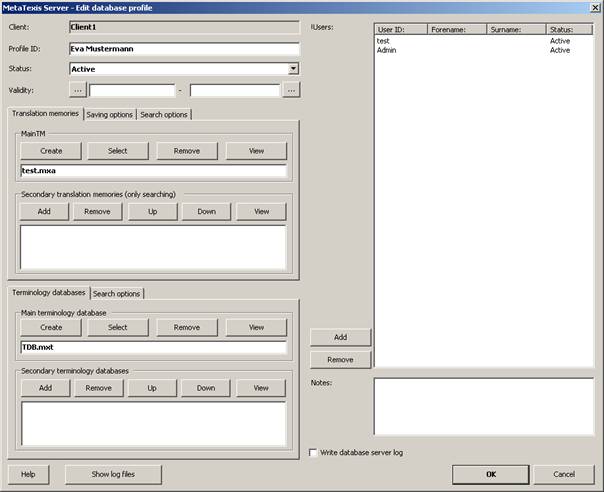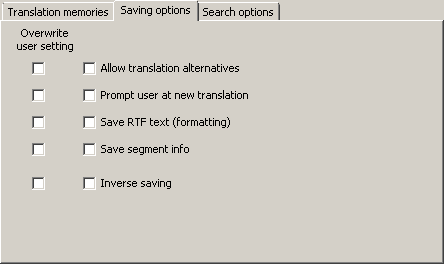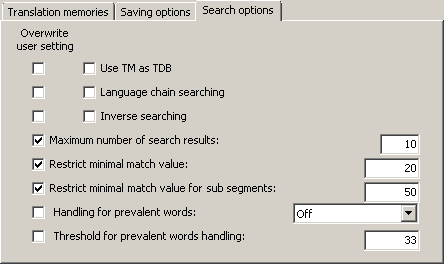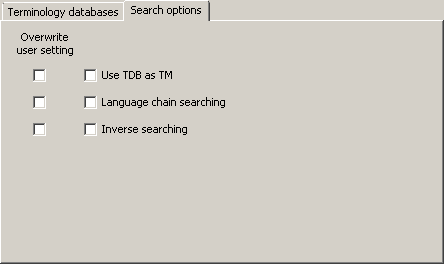
When you have clicked the button for adding or editing a database profile the following dialog will be displayed:

When you create a new database profile, two data must be defined, the profile ID and a TM and/or a TDB. All other settings are optional. Click OK to save the data.
The elements of the dialog are explained in detail below:
∑ Profile ID:
This is the only mandatory field. The profile ID can be changed at any time, the only restriction being that it must not be identical with another profile ID. (Note that when you have changed a profile ID which was already in use before you need to inform the affected users.)
∑ Status:
The status can be "Active" or "Not active". If the status is "Not active", no user can work with this database profile.
∑ Validity:
By setting the validity you can limit the time in which the database profile is active. Any client requests that are not in the limits of the dates set, will be rejected.
∑ Sub-Tabs for Translation memories:
In the sub-tab Translation memories you can define the main translation memory (which is used for searching and for saving translation units) and the secondary translation memories (that are only used for searching).
The sub-tab Saving options looks as follow:

The left column of checkboxes has the title Overwrite user setting. If on of these checkboxes is checked, the related setting next to is taken from the database profile and not from the saving request sent by the user who can set this option also in his client program.
▪ Allow translation alternatives:
When this checkbox is checked, MetaTexis does not update existing TUs in a TM, but adds another alternative. In most cases, you will probably prefer not to allow translation alternatives.
▪ Prompt user at new translation
Each time a TU is saved in the main TM, MetaTexis checks whether the source segment is already present in the TM.
Now, let us assume that you want to save a TU in the TM and the source segment of the TU is already present in the TM, but the translation of the TU to be saved is different from the translation present in the TM. If this checkbox is not checked, the translation in the TM will be updated automatically (or a new alternative will be added automatically). But if it is checked, you will be asked whether you want to update the translation (or whether you want to add a new translation alternative).
▪ Save RTF text (formatting)
When this checkbox is checked, the RTF version of each TU is saved in the TM. The RTF text includes all formatting information for the given TU. Saving the RTF text increases the size of the TM. So, if you do not need the formatting information and/or need to keep the size of the TM small, de-activate this option.
▪ Save segment info (statistical information)
When this checkbox is checked, the segment info for each segment is saved in the TM. This increases the size of the TM. Therefore, if you do not need this information and/or want to keep the size of the TM small, do not activate this option.
▪ Inverse saving:
When this checkbox is checked, MetaTexis will save a TU in inverse language direction, if the source text of the TU to be saved if found as translation in the TM. This feature can only be activated when the database has been activated for inverse searching and saving when it was created.
The sub-tab Search options looks as follow:

The left column of checkboxes has the title Overwrite user setting. If on of these checkboxes is checked, the related setting next to it is taken from the database profile and not from the search request sent by the user who can set this option also in his client program.
▪ Use TM as TDB:
When this checkbox is active the TM will also be used as TDB, that is, the TUs in the TM will be treated as terminology. This can increase the number of hits in some cases. However, be careful with this option because it can considerably increase the search time. Especially when the TMs get very big and when CJK languages are affected, it is not recommended to use the option.
▪ Language chain searching:
If this option is checked, the search will be extended to find more TUs if the TM contains multi-lingual content. For example, letís assume that you are translating a text from English to French (EN->FR). If the TM contains TUs in the language combinations EN->IT and IT->FR, where one EN segment is very similar or identical to the segment currently searched, the TM search will usually not be successful because there is no EN->FR dataset in the TM. However, if the language chain searching is active, MetaTexis will look further. And if the IT segments are identical, MetaTexis will actually find the French translation of the Italian text and assign it to the English source text, and an EN->FR hit will be displayed. This search even works across TMs!
Moreover, if the inverse searching is active, the language chain search even works if the language direction are mixed, e.g. MetaTexis will find a match if the TM has the TUs IT->EN and FR->IT.
▪ Inverse searching:
If this option is checked, the TMs will also be searched for matches with the opposite language direction. This option only works if the database is activated for inverse searching and saving when it is created. Combined with the language chain-searching feature, this opens up amazing possibilities (see above).
▪ Maximum number of search results:
When this setting is active, the maximum number of search results is limited to the number set.
▪ Restrict minimal match value:
When this setting is active, the minimal match value for fuzzy matches is restricted to the percentage set here. So, even if the user sends a request with a lower percentage, the value set here is used instead of the user setting. This option can be very important to keep search performance high (especially relevant for very big databases and for CJK languages).
▪ Restrict minimal match value for sub-segments:
When this setting is active, the minimal match value for sub-segment searching is restricted to the percentage set here. So, even if the user sends a request with a lower percentage, the value set here is used instead of the user setting. This option can be very important to keep search performance high (especially relevant for very big databases and for CJK languages).
∑ Sub-tabs for Terminology databases:
In the tab Terminology databases you can define the main terminology database (which is used for searching and for saving terminology) and the secondary translation memories (that are only used for searching).
The sub-tab Search options looks as follow:

The left column of checkboxes has the title Overwrite user setting. If on of these checkboxes is checked, the related setting next to it is taken from the database profile and not from the search request sent by the user who can set this option in his client program.
▪ Use TDB as TM:
When this checkbox is active the TDB will also be used as TM, that is, the terms in the TDB will be treated as TUs. This can increase the number of hits in some cases. However, be careful with this option because it can considerably increase the search time. Especially when the TDBs get very big and when CJK languages are affected, it is not recommended to use the option.
▪ Language chain searching:
If this option is checked, the search will be extended to find more terms if the TDB contains multi-lingual content. For example, letís assume that you are translating a text from English to French (EN->FR). If the TDB contains terms in the language combinations EN->IT and IT->FR, where one EN segment is very similar or identical to the segment currently searched, the TDB search will usually not be successful because there is no EN->FR dataset in the TDB. However, if the language chain searching is active, MetaTexis will look further. And if the IT segments are identical, MetaTexis will actually find the French translation of the Italian text and assign it to the English source text, and an EN->FR hit will be displayed. This search even works across TMs!
Moreover, if the inverse searching is active, the language chain search even works if the language direction are mixed, e.g. MetaTexis will find a match if the TM has the TUs IT->EN and FR->IT.
▪ Inverse searching:
If this option is checked, the TDBs will also be searched for matches with the opposite language direction. This option only works if the database is activated for inverse searching and saving when it is created. Combined with the language chain-searching feature this opens up amazing possibilities (see above).
∑ Users:
To assign users to the database profile, click the Add button next to the list of users and select one or more users in the dialog shown. To remove a user, select the user to remove and click the Remove button.
∑ Notes:
This field allows you to save additional information on the user.
∑ Write database server log:
When this checkbox is active, a log is created for this database profile.
∑ Button Show log files:
When you click this button, any log created for this database profile will be displayed.